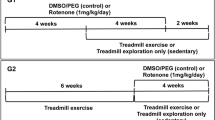Abstract
The higher risk for amyotrophic lateral sclerosis (ALS) among professional soccer players, recently reported in Italy, has stimulated investigations in the search for environmental factors that may be at the origin of the increased susceptibility to the disease. Here we studied if high concentrations of branched-chain amino acids (BCAAs), widely used among athletes as dietary integrators to improve physical performance, may be related to an excitotoxic neuronal cell damage. Our results show that (i) high concentrations of BCAAs are neurotoxic and increase excitotoxicity in cortical neurons; (ii) neurotoxicity is brain area specific, being detected in cortical, but not in hippocampal neurons; (iii) it is related to NMDA receptor overstimulation, since it is abolished in the presence of MK-801, a specific NMDA channel blocker; (iv) it depends on the presence of astrocytes. We describe here a possible biological link between an environmental factor (high dietary intake of BCAAs) and the increased risk of ALS among soccer players.




Similar content being viewed by others
References
Abel EL (2007) Football increases the risk for Lou Gehrig’s disease, amyotrophic lateral sclerosis. Percept Mot Skills 104:1251–1254
Bak LK, Johansen ML, Schousboe A, Waagepetersen HS (2007) Among the branched-chain amino acids, only valine metabolism is up-regulated in astrocytes during glutamate exposure. J Neurosci Res 85:3465–3470
Belli S, Vanacore N (2005) Proportionate mortality of Italian soccer players: is amyotrophic lateral sclerosis an occupational disease? Eur J Epidemiol 20:237–242
Bixel MG, Hutson SM, Hamprecht B (1997) Cellular distribution of branched-chain amino acid aminotransferase isoenzymes among rat brain glial cells in culture. J Histochem Cytochem 45:685–694
Choi DW (1988) Glutamate neurotoxicity and diseases of the nervous system. Neuron 1:623–634
Davis JM, Alderson NL, Welsh RS (2000) Serotonin and central nervous system fatigue: nutritional considerations. Am J Clin 72(2 Suppl):573S–578S
Fernstrom JD (2005) Branched-chain amino acids and brain function. J Nutr 135(6 Suppl):1539S–1546S
Fernstrom JD, Fernstrom MH (2007) Tyrosine, phenylalanine, and catecholamine synthesis and function in the brain. J Nutr 137(6 Suppl 1):1539S–1547S
Hutson SM, Sweatt AJ, Lanoue KF (2005) Branched-chain amino acid metabolism: implications for establishing safe intakes. J Nutr 135(6 Suppl):1557S–1564S
Lieth E, LaNoue KF, Berkich DA, Xu B, Ratz M, Taylor C, Hutson SM (2001) Nitrogen shuttling between neurons and glial cells during glutamate synthesis. J Neurochem 76:1712–1723
Malchiodi-Albedi F, Domenici MR, Paradisi S, Bernardo A, Ajmone-Cat MA, Minghetti L (2001) Astrocytes contribute to neuronal impairment in beta A toxicity increasing apoptosis in rat hippocampal neurons. Glia 34:68–72
Schousboe A, Waagepetersen HS (2005) Role of astrocytes in glutamate homeostasis: implications for excitotoxicity. Neurotox Res 8:221–225
Schulte-Frohlinde E, Wagenpfeil S, Willis J, Lersch C, Eckel F, Schmid R, Schusdziarra V (2007) Role of meal carbohydrate content for the imbalance of plasma amino acids in patients with liver cirrhosis. J Gastroenterol Hepatol 22:1241–1248
Shaw CA, Höglinger GU (2008) Neurodegenerative diseases: neurotoxins as sufficient etiologic agents? Neuromolecular Med 10:1–9
Simpson CL, Al-Chalabi A (2006) Amyotrophic lateral sclerosis as a complex genetic disease. Biochim Biophys Acta 1762:973–985
Van Damme P, Dewil M, Robberecht W, Van Den Bosch L (2005) Excitotoxicity and amyotrophic lateral sclerosis. Neurodegener Dis 2:147–159
Van Den Bosch L, Van Damme P, Bogaert E, Robberecht W (2006) The role of excitotoxicity in the pathogenesis of amyotrophic lateral sclerosis. Biochim Biophys Acta 1762:1068–1082
Vanacore N, Binazzi A, Bottazzi M, Belli S (2006) Amyotrophic lateral sclerosis in an Italian professional soccer player. Parkinsonism Relat Disord 12:327–329
Vucic S, Kierna MC (2009) Pathophysiology of neurodegeneration in familial amyotrophic lateral sclerosis. Curr Mol Med 9:255–272
Yudkoff M (1997) Brain metabolism of branched-chain amino acids. Glia 21:92–98
Yudkoff M, Daikhin Y, Nelson D, Nissim I, Erecińska M (1996) Neuronal metabolism of branched-chain amino acids: flux through the aminotransferase pathway in synaptosomes. J Neurochem 66:2136–2145
Acknowledgments
The authors wish to thank T.C. Petrucci, A.M.M. Di Stasi, L. Minghetti, and N. Vanacore for reading the manuscript and provide helpful comments. This work was partly funded by grant “Glutamatergic excitotoxicity and the role of BCAAs in ALS” from Ministero del Lavoro, della Salute e delle Politiche Sociali, N. 2008-10, to F.M.A.
Author information
Authors and Affiliations
Corresponding author
Rights and permissions
About this article
Cite this article
Contrusciere, V., Paradisi, S., Matteucci, A. et al. Branched-Chain Amino Acids Induce Neurotoxicity in Rat Cortical Cultures. Neurotox Res 17, 392–398 (2010). https://doi.org/10.1007/s12640-009-9115-0
Received:
Revised:
Accepted:
Published:
Issue Date:
DOI: https://doi.org/10.1007/s12640-009-9115-0




